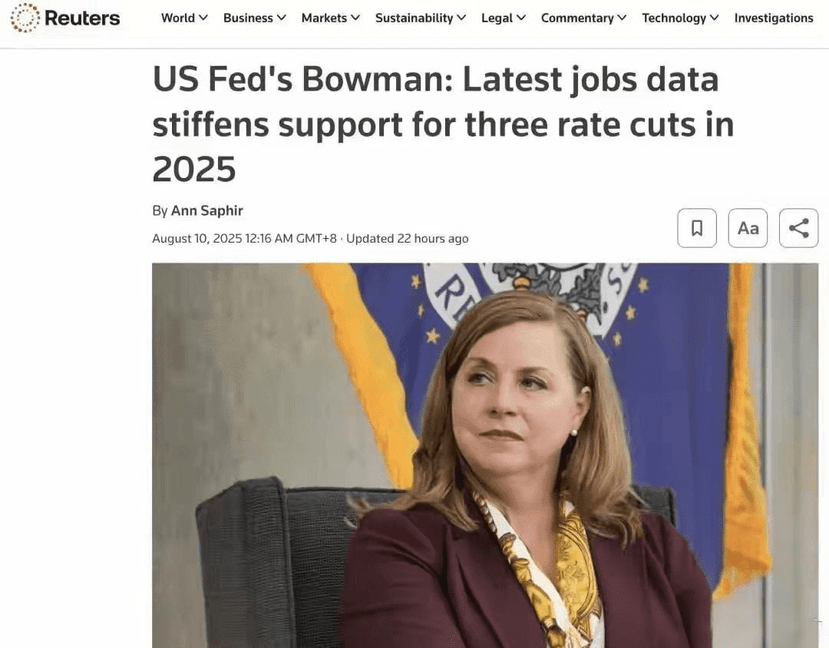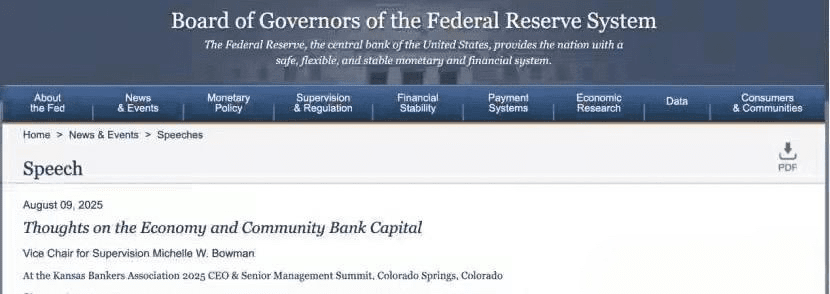Recently, there has been continuous controversy within the Federal Reserve regarding the direction of monetary policy, a debate that relates to the global value of money and is closely tied to everyone's wealth. The focus of the controversy is on Federal Reserve Vice Chair Michelle Bowman, whose recent statements have attracted significant market attention.
Bowman has made it clear that interest rates must be cut under the current circumstances, and that ideally there should be three rate cuts this year, strongly urging action to begin in September. It's worth noting that just a few months ago she was a staunch supporter of high interest rates, believing that controlling prices should be the priority. However, since June, her attitude has undergone a 180-degree turn, publicly supporting rate cuts in July and now urging her colleagues to take action in September. She is concerned that if action is not taken in a timely manner, public employment will be threatened, and waiting until the unemployment problem becomes severe to remedy it will come at a higher cost—better to prevent it in advance.
Bowman was appointed by former President Trump in 2018, and she also discussed tariff issues. Although many people are worried that tariffs imposed by the U.S. on goods from other countries will be passed on to the public, driving up prices, Bowman believes that this price increase is only temporary. In her view, since the risk of price increases has decreased, the Federal Reserve's focus should shift from controlling prices to protecting employment.

The root of Bowman's sudden change in attitude is the concerning employment data in the United States. In July, the U.S. added only 73,000 jobs, far below expectations, and the data for the previous two months was revised down, totaling a loss of nearly 260,000 jobs, indicating that the previously seemingly good employment situation was actually an illusion. The unemployment rate also rose from 4.1% to 4.2%, and Bowman stated it is close to 4.3%. Over the past three months, the average number of new jobs added each month in the U.S. was only 35,000, far below the healthy level (at least 100,000 per month) that economists believe. These data have led her to firmly believe in her judgment to cut interest rates; she predicted last year that there would be three rate cuts this year.
Currently, the market generally believes that a rate cut in September is a foregone conclusion. Data from the 'CME FedWatch' shows that the probability of a rate cut in September is as high as 88.9%, and the current suspense is about the extent of the rate cut.
The Federal Reserve has clearly divided into two factions. The 'employment-first faction', led by Bowman, includes San Francisco Fed President Daly, Minneapolis Fed President Kashkari, and governors Waller and Cook. They are deeply concerned about employment data and believe that interest rates must be lowered quickly to avoid a collapse in the labor market, prioritizing economic growth and public employment. The 'inflation-first faction', represented by New York Fed President Williams and Richmond Fed President Barkin, believes that the job market still has resilience and has not reached a critical point. They are more worried that premature rate cuts will allow inflation to return, undoing previous efforts to control it.

The two factions draw completely different conclusions based on the same economic data, with the core disagreement lying in the assessment of the current state of the U.S. economy. Ultimately, the key decision falls to Federal Reserve Chair Powell, whose decision will impact global markets.
The upcoming Jackson Hole Global Central Bank Annual Meeting, scheduled for August 21-23, will be an important opportunity to glimpse Powell's thoughts. This meeting is seen as a bellwether for global monetary policy, and the Federal Reserve Chair typically delivers important speeches at the meeting, revealing policy directions. If Powell believes that the Federal Reserve needs to shift from combating inflation to rescuing the job market, he is likely to send clear signals of a policy shift at this annual meeting. At that time, global investors will adjust their investment strategies based on his statements, and a game concerning the global economy and wealth is about to unfold. The September interest rate meeting is bound to be anything but calm, and each of us is part of this grand play.
